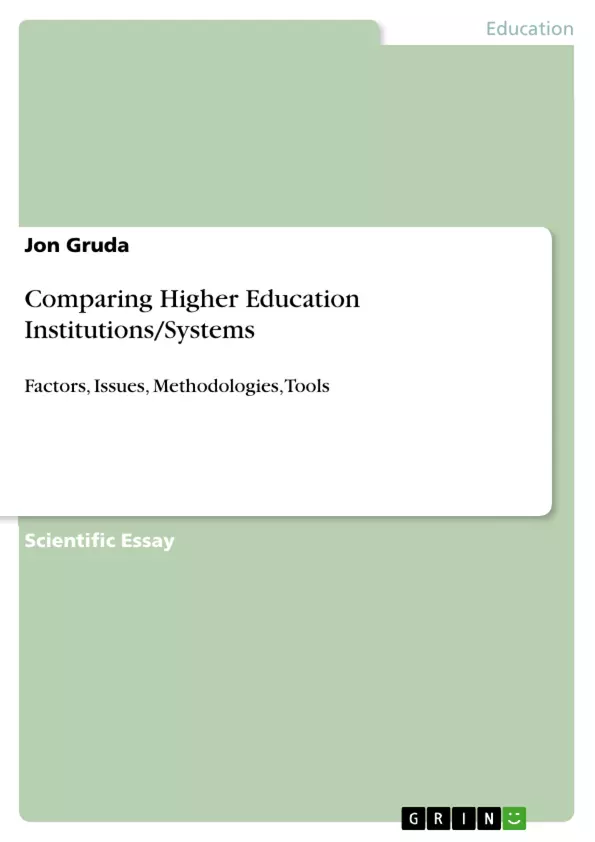Higher Education is a vital aspect of everyday life, not only for students or professors, but also for external observers, since education is the most discussed factor throughout this economic crisis. Considering the importance of this topic, it is hard to believe that there are indeed several papers published on the issue of comparing the variety of countries with reference to their individual higher education systems and their ranking scores, while there is not one universal concept/ model within academic ranks that is applied when conducting comparative country studies, with special attention to higher education systems.
Inhaltsverzeichnis (Table of Contents)
- 1 Introduction
- 2 Actors & Factors
- 2.1 Government
- 2.1.1 State Regulation
- 2.1.2 Management
- 2.1.3 Efficiency
- 2.2 Academic Institutions
- 2.2.1 Self-governance
- 2.2.2 Quality of Teaching
- 2.2.3 Research
- 2.2.4 Costs
- 2.2.5 Infrastructure
- 2.3 Under - Graduates
- 2.3.1 Entry Requirements
- 2.3.2 Economic Value Added
- 2.1 Government
- 3 Conclusion
- 4 Bibliography
Zielsetzung und Themenschwerpunkte (Objectives and Key Themes)
This paper aims to provide a comprehensive overview of the factors involved in comparing higher education systems across different countries. It explores the various actors and their roles in shaping these systems, focusing on the interplay between government, academic institutions, and students. The analysis incorporates diverse data and models from existing research to develop a framework for evaluating the relative strengths and weaknesses of different higher education systems.- The role of government in higher education systems, including state regulation, management, and efficiency.
- The importance of self-governance, quality of teaching, research, costs, and infrastructure in academic institutions.
- The impact of entry requirements and economic value added on the experience of undergraduate students.
- The use of comparative methodologies and tools for analyzing higher education systems.
- The influence of factors such as cultural context, economic development, and historical background on the development of higher education systems.
Zusammenfassung der Kapitel (Chapter Summaries)
- Chapter 1: Introduction This chapter sets the stage for the research by highlighting the importance of higher education, particularly in light of the global economic crisis. It points out the lack of a unified framework for comparing higher education systems across countries and introduces the key assumptions and analytical approach that will be employed in the paper.
- Chapter 2: Actors & Factors This chapter identifies and examines the major actors involved in higher education systems, specifically the government, academic institutions, and students. It analyzes the influence of each actor on the development and performance of higher education, highlighting the interplay and interdependence of these elements.
- Chapter 2.1: Government This section focuses on the role of the government in higher education systems, exploring key aspects such as state regulation, management, and efficiency. It investigates the degree of control governments exercise over universities, their management strategies, and their efforts to optimize the use of public funds allocated to higher education.
- Chapter 2.2: Academic Institutions This section delves into the internal functioning of academic institutions, examining factors such as self-governance, quality of teaching, research, costs, and infrastructure. It analyzes how these elements contribute to the success and standing of individual universities within their respective national and international contexts.
- Chapter 2.3: Under-Graduates This section focuses on the student perspective, exploring aspects such as entry requirements and the economic value added by higher education. It investigates the impact of these factors on the experiences of undergraduate students and their career prospects following graduation.
Schlüsselwörter (Keywords)
Higher education, comparative country studies, government, academic institutions, students, state regulation, management, efficiency, self-governance, quality of teaching, research, costs, infrastructure, entry requirements, economic value added, methodologies, tools, cultural context, economic development, historical background.- Quote paper
- Jon Gruda (Author), 2009, Comparing Higher Education Institutions/Systems, Munich, GRIN Verlag, https://www.grin.com/document/182181



